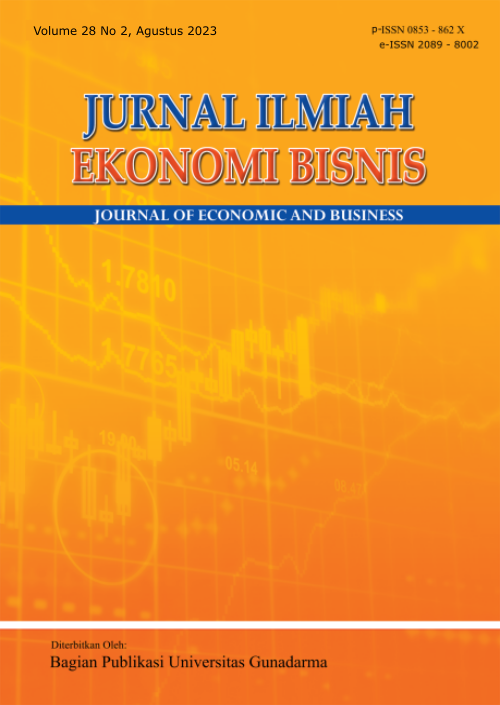PERSEPSI RISIKO: MINAT DAN PERILAKU BERWISATA DI NEW NORMAL APAKAH MASIH SAMA?
Universitas Bengkulu
Indonesia
Universitas Bengkulu
Indonesia
Universitas Bengkulu
Indonesia
Abstract
Wabah Covid-19 membuat masyarakat mulai merubah perilaku dan beradaptasi dengan kebiasaan hidup baru atau new normal. Penelitian ini meneliti minat dan perilaku berwisata di masa new normal dengan memasukkan variabel risiko (percieved risk) yang mempengaruhi behavior to visit dengan intention to visit sebagai mediasi. Penelitian ini juga memasukkan electronic word of mouth dan citra destinasi sebagai variabel independen yang juga mempengaruhi perilaku berkunjung dengan niat untuk berkunjung sebagai mediasi. Penelitian menggunakan pendekatan metode kuantitatif dengan 261 responden. Hasil yang didapatkan memperlihatkan adanya hubungan negatif dari persepsi risiko karena adanya kekhawatiran tertular virus Covid-19 terhadap niat untuk berkunjung (-0,325) maupun terhadap perilaku berkunjung dengan niat untuk berkunjung sebagai mediasi (-0,157). Variabel electronic word of mouth dan citra destinasi sama-sama memberikan pengaruh positif terhadap niat untuk berkunjung maupun terhadap perilaku berkunjung dengan niat untuk berkunjung sebagai mediasi. Hubungan yang memberikan pengaruh paling kuat dalam penelitian ini adalah pengaruh yang diberikan niat untuk berkunjung terhadap perilaku berkunjung dengan korelasi sebesar 0,484. Pengaruh yang diberikan dua dari tiga variabel independen (electronic word of mouth dan citra destinasi) dalam penelitian ini tergolong rendah. Perlu dilakukan penelitian kembali yang memperhatikan motivasi orang berwisata di masa new normal ini.
Keywords
References
Afrizal (2014). Metode penelitian kualitatif. Jakarta: Rajagrafindo.
Ajzen, I. (1985). From intentions to actions: A theory of planned behavior. Action Control, 11–39.
Ajzen, I. (1991). The theory of planned behavior. Organizational Behavior and Human Decision Processes, 50(2), 179–211. doi.org:10.1016/0749-5978(91)90020-T
Al Mamun, A., Mohamad, M. R., Yaacob, M. R. B., & Mohiuddin, M. (2018). Intention and behavior towards green consumption among low-income households. Journal of Environmental Management, 227(2018), 73–86. doi.org:10.1016/j.jenvman.2018.08.061
Arifin, A. (2022). Fenomena penggunaan media sosial. Retrieved from: https://www.voaindonesia.com/a/fenomena-penggunaan-media-sosial/6631266.html
Arora, T., & Grey, I. (2020). Health behaviour changes during COVID-19 and the potential consequences: A mini-review. Journal of Health Psychology, 25(9), 1155–1163. doi.org:10.1177/1359105320937053
Badan Pusat Statistik. (2020). Jumlah kunjungan wisatawan mancanegara per bulan ke Indonesia menurut pintu masuk, 2017 - sekarang. Retrieved from: https://www.bps.go.id/indicator/16/1150/3/jumlah-kunjungan-wisatawan-mancanegara-per-bulan-ke-indonesia-menurut-pintu-masuk-2017---sekarang.html
Bambauer-Sachse, S., & Mangold, S. (2011). Brand equity dilution through negative online word-of-mouth communication. Journal of Retailing and Consumer Services, 18(1), 38–45. doi.org:10.1016/j.jretconser.2010.09.003
Beerli, A., & Martín, J. D. (2004). Factors influencing destination image. Annals of Tourism Research, 31(3), 657–681. doi.org:10.1016/J.ANNALS.2004.01.010
Bobâlcă, C. (2014). Determinants of customer loyalty: A theoretical approach. Journal of International Scientific Publications, 8, 995–1005.
Bonsón, E., Perea, D., & Bednárová, M. (2019). Twitter as a tool for citizen engagement: An empirical study of the Andalusian municipalities. Government Information Quarterly, 36(3), 480–489. doi.org:10.1016/j.giq.2019.03.001
Casaló, L. V., Flavián, C., & Guinalíu, M. (2011). Understanding the intention to follow the advice obtained in an online travel community. Computers in Human Behavior, 27(2), 622–633. doi.org:10.1016/J.CHB.2010.04.013
Chen, C., Chen, W., & Chen, W. (2014). Understanding the effects of ewom on cosmetic consumer behavioral intention. International Journal of Electronic Commerce Studies, 5(1), 97–102. doi.org:10.7903/ijecs.1030
Chien, P. M., Sharifpour, M., Ritchie, B. W., & Watson, B. (2016). Travelers’ health risk perceptions and protective behavior: A psychological approach. Journal of Travel Research, 56(6), 744–759. doi.org:10.1177/0047287516665479
Donald, I. J., Cooper, S. R., & Conchie, S. M. (2014). An extended theory of planned behaviour model of the psychological factors affecting commuters’ transport mode use. Journal of Environmental Psychology, 40, 39–48. doi.org:10.1016/j.jenvp.2014.03.003
Elliot, S. (2014). Behavior, tourist. In book Encyclopedia of Tourism (pp. 1–3). New York: Springer International Publishing. doi.org:10.1007/978-3-319-01669-6_17-1
Fang, C., & Zhang, J. (2019). Users’ continued participation behavior in social Q&A communities: A motivation perspective. Computers in Human Behavior, 92, 87–109. doi.org/10.1016/j.chb.2018.10.036.
Greaves, N., & Skinner, H. (2010). The importance of destination image analysis to UK rural tourism. Marketing Intelligence and Planning, 28(4), 486–507. doi.org:10.1108/02634501011053586.
Gunn, C. A. (1972). Vacationscape, Bureau of Business Research. United Kingdom: Routledge, Taylor & Francis.
Hennessey, S., Yun, D., & MacDonald, R. M. (2012). Determinants of travel intentions to a Neighbouring Destination. SSRN Electronic Journal. doi.org:10.2139/ssrn.1617370
Hosseini, S. (2015). Survey the relationships between destination image, tourist satisfaction and destination loyalty. International Journal of Research In Social Sciences, 5(6), 27–43.
Jacoby, J., & Kaplan, L. B. (1972). “The Components of Perceived Risk.” SV - Proceedings of the Third Annual Conference of the Association for Consumer Research, 382–393.
Jalilvand, M. R., Ebrahimi, A., & Samiei, N. (2013). Electronic Word of Mouth Effects on Tourists’ Attitudes Toward Islamic Destinations and Travel Intention: An Empirical Study in Iran. Procedia - Social and Behavioral Sciences, 81(2006), 484–489. doi.org:10.1016/j.sbspro.2013.06.465
Jalilvand, M. R., & Samiei, N. (2012). The impact of electronic word of mouth on a tourism destination choice: Testing the theory of planned behavior (TPB). Internet Research, 22(5), 591–612. doi.org:10.1108/10662241211271563
Jonas, A., Mansfeld, Y., Paz, S., & Potasman, I. (2010). Determinants of health risk perception among low-risk-taking tourists traveling to developing countries. Journal of Travel Research, 50(1), 87–99. doi.org:10.1177/0047287509355323
Kotler, P., Kartajaya, H., & Setiawan, I. (2017). Marketing 4.0: Moving from traditional to digital. John Wiley & Sons Inc.
Lepp, A., & Gibson, H. (2003). Tourist roles, perceived risk and international tourism. Annals of Tourism Research, 30(3), 606–624. doi.org:10.1016/S0160-7383(03)00024-0
Li, J., Zuo, J., Cai, H., & Zillante, G. (2018). Construction waste reduction behavior of contractor employees: An extended theory of planned behavior model approach. Journal of Cleaner Production, 172, 1399–1408. doi.org:10.1016/j.jclepro.2017.10.138
Malik, S., Mahmood, S., & Rizwan, M. (2014). Examining customer switching behavior in cellular industry. Journal of Public Administration and Governance, 4(2), 114-128. doi.org:10.5296/jpag.v4i2.5840
Prasatya, N. W. D. & Selly, M. (2013). Analisis pengaruh destination image terhadap persepsi konsumen mengenai destination s domestic product: Studi kasus buah durian Thailand (Undergraduate thesis). Program Studi Manajemen, Fakultas Ekonomi dan Bisnis, Universitas Indonesia.
Reisinger, Y., & Mavondo, F. (2005). Travel anxiety and intentions to travel internationally: Implications of travel risk perception. Journal of Travel Research, 43(3), 212–225. doi.org:10.1177/0047287504272017
Rufai, S. R., & Bunce, C. (2020). World leaders’ usage of Twitter in response to the COVID-19 pandemic: a content analysis. Journal of Public Health, 42(3), 510–516. doi.org:10.1093/pubmed/fdaa049
Van, N. T., Vrana, V., Duy, N. T., Minh, D. X., Dzung, P. T., Mondal, S. R., & Das, S. (2020). The role of human–machine interactive devices for post-COVID-19 innovative sustainable tourism in Ho Chi Minh City, Vietnam. Sustainability 12(22), 1-30. doi.org:10.3390/su12229523
Vuuren, V.C, & Slabbert, E.,(2011). Travel motivations and behaviour of tourist to a South African. Book of Proceeding of International Conference on Tourism and Management Studies, 295–304.
Wang, C. Y., & Hsu, M. K. (2010). The relationships of destination image, satisfaction, and behavioral intentions: An integrated model. Journal of Travel and Tourism Marketing, 27(8), 829–843. doi.org:10.1080/10548408.2010.527249
Wang, J., Liu-Lastres, B., Ritchie, B. W., & Mills, D. J. (2019). Travellers’ self-protections against health risks: An application of the full Protection Motivation Theory. Annals of Tourism Research, 78, 102743. doi.org:10.1016/j.annals.2019.102743
Wang, P. (2014). Understanding the influence of electronic word-of-mouth on outbound tourists’ visit intention. IFIP Advances in Information and Communication Technology, 445, 33–45. doi.org:10.1007/978-3-662-45526-5_4
Wang, P. (2015). Exploring the influence of electronic word-of-mouth on tourists’ visit intention: A dual process approach. Journal of Systems and Information Technology, 17(4), 381–395. doi.org:10.1108/JSIT-04-2015-0027
Williams, A. M., & Baláž, V. (2014). Tourism Risk and Uncertainty: Theoretical Reflections. Journal of Travel Research, 54(3), 271–287. doi.org:10.1177/0047287514523334
World Tourism Organization. (2020). Impact assessment of the Covid-19 outbreak on international tourism. Retrieved from: https://www.unwto.org/impact-assessment-of-the-covid-19-outbreak-on-international-tourism
Xue, D. (2015). Analyzing the relation between perceived risk and customer involvement : Based on the bank financial product. International Journal of Economics, Commerce and Management, III(2), 1–7.
Yacob, S., Johannes, J., & Qomariyah, N. (2019). Visiting intention: A perspective of destination attractiveness and image in Indonesia rural tourism. Sriwijaya International Journal of Dynamic Economics and Business, 3(2), 122-133.
Yacoub, I., & Hamouda, M. (2018). Explaining visit intention involving eWOM, perceived risk motivations and destination image. International Journal of Leisure and Tourism Marketing, 6(1), 65. doi.org:10.1504/ijltm.2018.10009971
Yen, Y.-S. (2015). Managing perceived risk for customer retention in e-commerce: The role of switching costs. Information & Computer Security, 23(2), 145–160.
Yung, R., Khoo-Lattimore, C., & Potter, L. E. (2021). Virtual reality and tourism marketing: conceptualizing a framework on presence, emotion, and intention. Current Issues in Tourism, 24(11), 1505–1525. doi.org:10.1080/13683500.2020.1820454
Zhang, H., Fu, X., Cai, L. A., & Lu, L. (2014). Destination image and tourist loyalty: A meta-analysis. Tourism Management, 40, 213–223. doi.org:10.1016/J.TOURMAN.2013.06.006
Zhang, K., Hou, Y., & Li, G. (2020). Threat of infectious disease during an outbreak: Influence on tourists’ emotional responses to disadvantaged price inequality. Annals of Tourism Research, 84, 102993. doi.org:10.1016/j.annals.2020.102993


